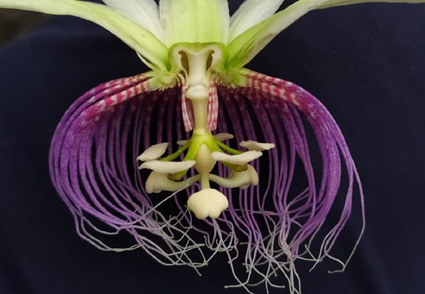Abstract
A new species from Costa Rica is described following a closer analysis of the Passiflora nitida complex. Given that the actual true identification of Passiflora nitida typified from Venezuela but distributed throughout South America was rather poorly constrained, the new species presented here was long identified incorrectly as supposedly being a form of P. nitida, for it sharing several floral characteristics. Following intense revision of the source literature, supplemented by fieldwork across Central America, the Costa Rican accessions of “Passiflora nitida” appeared to be significantly different from its South American counterpart in several morphological and habitational characteristics. While it was found that true Passiflora nitida only inhabits non-volcanic terrains, Passiflora brauliensis sp. nov. presented in this paper attributes to be the only member of this complex endemic to solely volcanic regions, where it is found in wet lowland to premontane transitional forest on the eastern flanks of Costa Rica’s most active volcanoes. The ecology, distribution, and association with the Passiflora nitida complex is highlighted, as well as its relationship with the other species within Passiflora supersect. Laurifoliae found throughout Latin America.
References
<p>Estrada, A. & Rodríguez, A. (2009) <em>Flores de pasión de Costa Rica: Historia natural e identificación</em>. Instituto Nacional de Biodiversidad, INBio. Costa Rica, 448 pp. [ISBN 978-9968-927-41-3]</p>
<p>Evans, S. (2010) <em>The green republic: A conservation history of Costa Rica</em>. University of Texas Press, 335 pp. [ISBN 978-0292-721-00-5]</p>
<p>Feuillet, C. & MacDougal, J.M. (2003 [2004]) A new infrageneric classification of <em>Passiflora</em> L. (Passifloraceae). Passiflora: <em>The Journal & Newsletter of Passiflora Society International</em> 13: 34–38. https://doi.org/10.2307/3393379</p>
<p>Hemsley, W.B. (1902) Passiflora ambigua, native of Nicaragua. <em>Botanical Magazine</em> 128: t. 7822.</p>
<p>Holdridge, L.R. (1967) <em>Life Zone Ecology</em>. Revised Edition. San José: Tropical Science Center, 206 pp. https://doi.org/10.4236/oalib.1102321</p>
<p>IUCN Standards and Petitions Committee (2022) Guidelines for Using the IUCN Red List Categories and Criteria. Version 15.1. Prepared by the Standards and Petitions Committee. [https://www.iucnredlist.org/documents/RedListGuidelines.pdf]</p>
<p>Killip, E.P. (1938) The American species of <em>Passifloraceae</em>. Publications of the Field Museum of Natural History. <em>Botanical Series</em> 19: 1–613. https://doi.org/10.5962/bhl.title.2269</p>
<p>Knapp, S.D. & Mallet, J. (1984) Two new species of Passiflora (Passifloraceae) from Panama, with comments on their natural history. <em>Annals of the Missouri Botanical Garden</em> 71: 1070–1074. https://doi.org/10.2307/2399243</p>
<p>Kuethe, J.R. (2020) <em>Passiflora</em> – List of recognized species – 2020. Published on ResearchGate.</p>
<p>Kuethe, J.R. & Meerman, J. (2022) Describing<em> Passiflora coloranigra,</em> a striking new species of <em>Passiflora</em> supersection <em>Laurifoliae</em> (Passifloraceae) from Panama. <em>Phytotaxa </em>561 (2): 191–198. https://doi.org/10.11646/phytotaxa.561.2.7</p>
<p>Kunth, K.S. (1817) Passiflora nitida. <em>Nova Genera et Species Plantarum</em> (quarto ed.) 2: 1–130.</p>
<p>Kuntze, C.E. (1891) Leges Nomenclaturae Internationales cum Enumeratione Plantarum Exoticarum. <em>Revisio Generum Plantarum</em> 1: 201. https://doi.org/10.5962/bhl.title.327</p>
<p>Lamarck, P.B.A.D. (1789) Botanique. <em>Encyclopédie Méthodique</em> 3: 36.</p>
<p>Linnaeus, C.V. (1753) Species Plantarum 2. 955 pp.</p>
<p>Sader, S.A. & Joyce, A.T. (1988) Deforestation rates and trends in Costa Rica, 1940 to 1983. <em>Biotropica: </em>11–19. https://doi.org/10.2307/2388421</p>
<p>Souza, M.A.D.D. (2011) <em>Passiflora fissurosa</em>, uma nova espécie de Passifloraceae para o Amazonas, Brasil. <em>Acta Amazonica</em> 41: 450. https://doi.org/10.1590/S0044-59672011000400002</p>
<p>Sprengel, C.P.J. (1826) Monadelphia Pentendria Passiflora. <em>Systema Vegetabilium, editio decima sexta</em> 3: 42.</p>
<p>Thiers, B. (2022) Index Herbarium: a global directory of public herbaria and associated staff. New York Garden’s Virtual Herbarium. Available from: http://sweetgum.nybg.org/science/ih/ (accessed 12 January 2023)</p>
<p>TROPICOS (2022) Tropicos.org: Nomenclatural, bibliographic, and specimen data accumulated in MBG’s electronic databases. Missouri Botanical Garden. Available from: http://www.tropicos.org (accessed 22 January 2023)</p>
<p>Ulmer, T. & MacDougal, J.M. (2004) <em>Passiflora: Passion flowers of the world</em>. Timber Press, Portland, Cambridge, 430 pp. [ISBN: 0881926485]</p>


